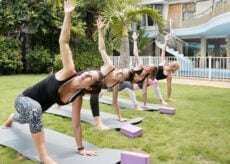5 Exercises that Reduce Lower Back Pain (see photos)

In today’s society—with so much work done at computers and so few people engaging in effective strength and flexibility programs—more and more people are suffering from low-back pain. According to Daniel Steffens, Ph.D., University of Sydney, Australia, and George Institute Fellow, “Low back pain is a significant global health burden, yet there is a lack of clear guidelines for prevention, and interventions include everything from shoe insoles to education.” What about exercise? Are there exercises to help reduce lower back pain?
The answer is yes, especially when coupled with other preventative measures. But you may be surprised to know that to strengthen your back and relieve pain, it’s important to start with your core.
Why Are Core Exercises So Important?
It’s simple. Lower back pain is also related to a weak core. Studies show that strengthening your core (abdominal muscles, back muscles, pelvic region) can significantly help when it comes to reduce lower back pain.
While the conventional American way of coping with pain tends to be medications, exercises that strengthen this area are the first line of defense. Motor control and core exercises are proven to help reduce lower back pain. According to physiotherapist Bruno Saragiotto from The George Institute, “Targeting the strength and coordination of muscles that support the spine through motor control exercise offers an alternative approach to treating lower back pain.”
What are motor control exercises? These are exercises designed to help you strengthen your core, pelvic, and lumbar muscles and are typically performed without weight. By engaging and activating these muscles repeatedly, you help create a muscle “corset” in your midsection, which helps support your lower back.
Ready to see how it works for you?
Try These Exercises to Reduce Lower Back Pain
While scientists can’t decide on the most effective exercises to help reduce lower back pain, they do agree that exercise itself will definitely help. Try the following (after a good warmup) and see if your back pain is lessened over time. As always, please consult with your healthcare practitioner prior to embarking on any new exercise program.

Hamstring Stretch—hamstrings are known to get extremely tight, especially if you sit much of the day or work legs often and don’t take the necessary time to stretch. Your hamstrings run from your pelvis all the way down to the back of your knees. So, you can see how tight hamstrings would have the ability to “pull” on your lower back muscles (and even your knees) and cause misalignment and thus pain.
Begin by lying flat on your back with your legs outstretched in front of you. Bend your right knee upward and grab your leg behind the knee with both hands. Gently pull your leg toward your abdomen and then straighten your leg to the best of your ability. Hold this stretch for 20 seconds and release and move slowly back to the beginning position. Repeat on the opposite side.
Note: you may also use a yoga strap to help you perform this stretch.

Cat-Cow Stretch—begin on all fours. Suck in your stomach and arch your back upward while dropping your head down toward the ground, rounding your back. Feel a good stretch throughout all your vertebrae. Next, move to the opposite position by pushing your stomach toward the ground while arching your back and raising your head upward. Hold this for a moment and then finish the move by dropping your hips back onto (or toward, depending on how flexible your hips are) your feet and stretching your arms out straight in front of you into child’s pose. Feel the nice stretch throughout your back, abs, and shoulder girdle as you take a moment to enjoy this series of poses (and see how this exercise may help reduce lower back pain over time).

Piriformis Stretch—this stretches a muscle that runs through the glutes, which when tight can exacerbate lower back pain. Begin by lying on your back with your knees bent and your feet close to your glutes. Lift your right leg up off the floor, and cross it over your left leg (forming a figure four), placing your foot and calf over the front of your left knee. If you need a greater stretch, lift the left leg up off the floor and wrap your hands around the back of your thigh, pulling the lower leg toward you as you push your right knee out to the side with your elbow. Hold and feel the stretch through your hamstrings and glute areas. Release back to the starting position and repeat on the opposite side.

Spinal Twist—begin by lying on your back with your knees bent and your arms outstretched to the sides, palms facing down. Bend your knees so your feet are close to your hips. With your knees together, pick your feet up off the floor and rotate your hips to the right, while keeping your shoulders on the ground, as you let your knees slowly “fall,” while under control, to the right side. Feel the stretch in your back for a few moments and then bring your knees back to the upright position. Repeat on the opposite side.

Crunch—again, strengthening your abdominals will help you strengthen your core, overall, and can assist in reducing back pain. This mainstream exercise is easy to do and can be done virtually anywhere at any time. Begin by lying on the floor on your back. Bend your knees and keep your feet about hip-width apart. With your hands resting gently behind your head (do not pull on your neck), raise your torso toward the ceiling by contracting and squeezing your abs and pulling your bellybutton in toward your spine. Hold for a moment and return to start. Repeat 10 – 20 times for one set. Aim for 2 – 3 sets.







